[Culture] The Hangang River: Seoul’s Beloved Landmark and Hub of Leisure and Festivals
Riverside view at Ttukseom Hangang Park
The Hangang River, which flows through Seoul is used as a source of potable water for people living in greater Seoul and is also a place where people can experience nature amid the gray concrete jungle.
Despite its current popularity, the Hangang River has not always been cherished by the citizens. During the period of industrialization and urbanization, it suffered from severe pollution caused by rapid industrial growth.
However, government-led redevelopment efforts have transformed it into a citizen-friendly space. With the creation of waterfront spaces, the Hangang River has become a hub for daily leisure activities and cultural festivals. In particular, unique events that celebrate rest and relaxation attract large numbers of visitors.
The history of the Hangang River
The Hangang River has played an essential role throughout Korean history. During the Three Kingdoms Period, when Goguryeo, Baekje, and Silla competed on the Korean Peninsula, the river served as a crucial battlefield among the three kingdoms. The kingdom that held control over the river basin often reached its peak and flourished. Thanks to its abundant water and fertile soil for agriculture, and its function as a trade route, the river was economically invaluable.
Still, the value of the Hangang River is not confined to economics alone. An estimated 1 to 1.5 kilometer in width, the Hangang River is considered wide not only by Korean standards but also on a global scale. This made it a key strategic point for defending against enemy invasions.
Over time, however, the river faced serious environmental challenges. As Seoul industrialized and urbanized, water pollution worsened. Large amounts of industrial waste flowed into the river, damaging the ecosystem. Additionally, paved surfaces expanded across the city, preventing rainwater from being absorbed into the ground. As a result, more rainwater flowed directly into the river, increasing the risk of flooding.
Ahead of the 1988 Seoul Olympics, the South Korean government initiated plans to improve the urban aesthetics. To this end, it implemented the Hangang River Comprehensive Development Project. A weir was built in Jamsil to control the water level, allowing for stable water levels throughout the year. In addition, four new sewage treatment plants were constructed in Jungnang, Tancheon, Nanji, and Seonam, which helped improve the water quality.
The Rise of the Hangang River as a Cultural Space
With its improved appearance, the Hangang River began to establish itself as a space for citizen engagement and culture in the 2010s. Launched in 2006, the Seoul Metropolitan Government’s Hangang River Renaissance Project aimed to revitalize the riverfront. The city expanded public transportation along the river and improved pedestrian access across bridges, making the river more accessible. In addition, the city installed sports facilities and convenience stores along the waterfront to create engaging spaces for public participation.
As a result, more citizens began visiting the river. According to the Future Hangang project Headquarters in Seoul Metropolitan Governement, the number of visitors to Hangang River Parks rose from about 38.83 million in 2009 to nearly 60 million during the 2010s.
The Hangang River has steadily maintained its popularity and is now recognized as a representative landmark of South Korea. According to the 2024 Seoul Landmark Awareness survey conducted by the Seoul Metropolitan Government, the Hangang River was selected as the most preferred landmark in South Korea, surpassing Gwanghwamun, Namdaemun, and N Seoul Tower across all age groups from people in their 20s to those over 60.
This marks a three-step rise from its fourth-place ranking in 2010. Especially, more than 60% of respondents in their 20s chose the Hangang River, showing a stronger preference compared to other age groups.
Kwak Min-jae, a student at Yonsei University, said he visits the river every other week to take part in a skateboarding crew. “After we skate, we eat delivery food and drink beer together while watching the sunset,” he said. For him, the Hangang River is a place where he can meet like-minded people and feel a sense of connection. “Many of the people there are around my age, so it’s easier to approach them,” he added.
The Growing Popularity of Relaxation-themed Festivals and competitions
As part of its efforts to promote citizen engagement, the Future Hangang project Headquarters in Seoul Metropolitan Governement has organized a variety of festivals and competitions. Amid today’s hectic modern life, unconventional festivals focused on relaxation have become especially popular. The paradoxical mix of competition and relaxation strikes a chord with modern citizens who are seeking balance in their lives.
One notable example is the “Hangang River Space-out Competition,” which has enjoyed steady popularity for over a decade. In this unique event, participants simply sit still and zone out. Ironically, the ability to do nothing becomes the key to winning. In the 2016 competition, the well-known singer Crush won first place, drawing significant media attention. Additionally, the “Hangang River Sleeping Contest” held for the first time last year, received an enthusiastic response, with registration closing just four hours after it opened.
The Hangang River, located at the heart of Seoul, has evolved into one of the nation’s most iconic landmarks. Its popularity stems not only from its scenic beauty, but also from the active involvement of citizens. Led by the Seoul Metropolitan Government, a variety of festivals reflecting citizens’ needs have been organized.
As a result, the Hangang River is now visited by countless people of all ages and nationalities. It is no longer just a beloved focal point within Seoul—it has become one of the most cherished places in the entire country.
There are no registered comments.
I agree to the collection of personal information. [view]


